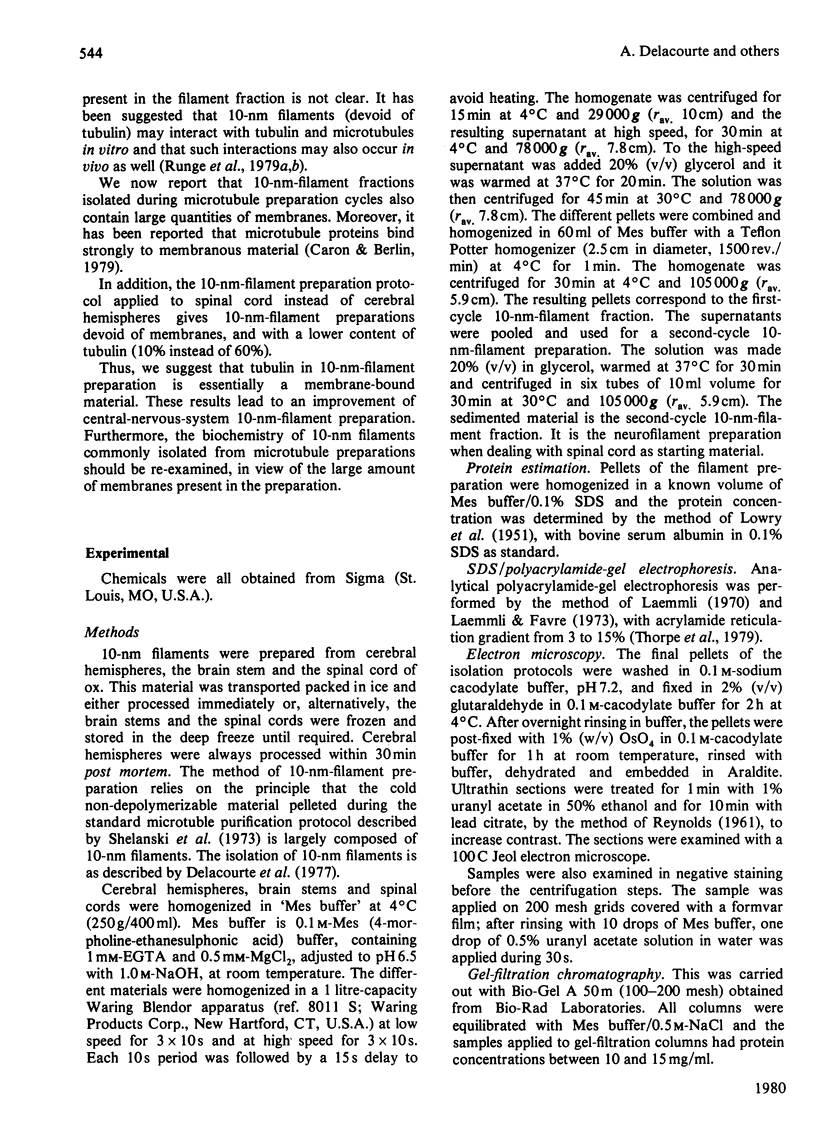Abstract
The cold non-depolymerizable fractions obtained during the standard procedure for the isolation of microtubules from ox brain stem-cerebral hemispheres and spinal cord have been studied. The cerebral-hemisphere preparation was composed of 10-nm filaments but also contained large amounts of membranes. The polypeptide content included tubulin, microtubule-associated proteins and minor proteins corresponding to the neurofilament triplet of proteins of mol.wt. 210 000, 160 000 and 70 000 respectively. The brain-stem preparation contained more 10-nm filaments than membranes. The polypeptide content consisted of the neurofilament triplet (35%), tubulin (30%) and minor proteins. In contrast, the spinal-cord preparation was mainly composed of 10-nm filaments, free of membranes and containing essentially the neurofilament protein triplet (64%). These filaments appeared very similar to the peripheral-nervous-system neurofilaments described by several authors. Since the best neurofilament from the central nervous system often contained less than 15% of the neurofilament protein triplet, our spinal-cord preparation is an improvement on the usual neurofilament preparation. This simple and rapid method gave large amounts of 10-nm filaments (100 mg per 100 g of spinal cord) characterized by the absence of membranous material, a low content of tubulin and the 50 000-mol.wt.-protein component, and a high content of neurofilament peptides. Thus, the presence of tubulin in 10-nm filament preparations seems to be related to the contaminant membranous material and not to be linked to the interaction in vitro of tubulin or microtubules with neurofilaments, as has been suggested previously.
Full text
PDF





Images in this article
Selected References
These references are in PubMed. This may not be the complete list of references from this article.
- Anderton B. H., Ayers M., Thorpe R. Neurofilaments from mammalian central and peripheral nerve share certain polypeptides. FEBS Lett. 1978 Dec 1;96(1):159–163. doi: 10.1016/0014-5793(78)81083-7. [DOI] [PubMed] [Google Scholar]
- Berkowitz S. A., Katagiri J., Binder H. K., Williams R. C., Jr Separation and characterization of microtubule proteins from calf brain. Biochemistry. 1977 Dec 13;16(25):5610–5617. doi: 10.1021/bi00644a035. [DOI] [PubMed] [Google Scholar]
- Bignami A., Dahl D. Specificity of the glial fibrillary acidic protein for astroglia. J Histochem Cytochem. 1977 Jun;25(6):466–469. doi: 10.1177/25.6.69656. [DOI] [PubMed] [Google Scholar]
- Caron J. M., Berlin R. D. Interaction of microtubule proteins with phospholipid vesicles. J Cell Biol. 1979 Jun;81(3):665–671. doi: 10.1083/jcb.81.3.665. [DOI] [PMC free article] [PubMed] [Google Scholar]
- Delacourte A., Plancot M. T., Han K. K., Hildebrand H., Biserte G. Investigation of tubulin fibers formed during microtubule polymerization cycles. FEBS Lett. 1977 May 1;77(1):41–46. doi: 10.1016/0014-5793(77)80189-0. [DOI] [PubMed] [Google Scholar]
- Laemmli U. K., Favre M. Maturation of the head of bacteriophage T4. I. DNA packaging events. J Mol Biol. 1973 Nov 15;80(4):575–599. doi: 10.1016/0022-2836(73)90198-8. [DOI] [PubMed] [Google Scholar]
- Liem R. K., Yen S. H., Salomon G. D., Shelanski M. L. Intermediate filaments in nervous tissues. J Cell Biol. 1978 Dec;79(3):637–645. doi: 10.1083/jcb.79.3.637. [DOI] [PMC free article] [PubMed] [Google Scholar]
- REYNOLDS E. S. The use of lead citrate at high pH as an electron-opaque stain in electron microscopy. J Cell Biol. 1963 Apr;17:208–212. doi: 10.1083/jcb.17.1.208. [DOI] [PMC free article] [PubMed] [Google Scholar]
- Runge M. S., Detrich H. W., 3rd, Williams R. C., Jr Identification of the major 68,000-dalton protein of microtubule preparations as a 10-nm filament protein and its effects on microtubule assembly in vitro. Biochemistry. 1979 May 1;18(9):1689–1698. doi: 10.1021/bi00576a009. [DOI] [PubMed] [Google Scholar]
- Runge M. S., Hewgley P. B., Puett D., Williams R. C., Jr Cyclic nucleotide phosphodiesterase activity in 10-nm filaments and microtubule preparations from bovine brain. Proc Natl Acad Sci U S A. 1979 Jun;76(6):2561–2565. doi: 10.1073/pnas.76.6.2561. [DOI] [PMC free article] [PubMed] [Google Scholar]
- Schlaepfer W. W., Freeman L. A. Neurofilament proteins of rat peripheral nerve and spinal cord. J Cell Biol. 1978 Sep;78(3):653–662. doi: 10.1083/jcb.78.3.653. [DOI] [PMC free article] [PubMed] [Google Scholar]
- Schlaepfer W. W. Studies on the isolation and substructure of mammalian neurofilaments. J Ultrastruct Res. 1977 Nov;61(2):149–157. doi: 10.1016/s0022-5320(77)80081-6. [DOI] [PubMed] [Google Scholar]
- Shelanski M. L., Gaskin F., Cantor C. R. Microtubule assembly in the absence of added nucleotides. Proc Natl Acad Sci U S A. 1973 Mar;70(3):765–768. doi: 10.1073/pnas.70.3.765. [DOI] [PMC free article] [PubMed] [Google Scholar]
- Shelanski M. L., Liem R. K. Neurofilaments. J Neurochem. 1979 Jul;33(1):5–13. doi: 10.1111/j.1471-4159.1979.tb11699.x. [DOI] [PubMed] [Google Scholar]
- Thorpe R., Delacourte A., Ayers M., Bullock C., Anderton B. H. The polypeptides of isolated brain 10nm filaments and their association with polymerized tubulin. Biochem J. 1979 Aug 1;181(2):275–284. doi: 10.1042/bj1810275. [DOI] [PMC free article] [PubMed] [Google Scholar]
- Yen S. H., Dahl D., Schachner M., Shelanski M. L. Biochemistry of the filaments of brain. Proc Natl Acad Sci U S A. 1976 Feb;73(2):529–533. doi: 10.1073/pnas.73.2.529. [DOI] [PMC free article] [PubMed] [Google Scholar]




